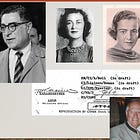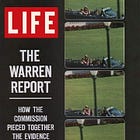Einstein's Addendum to the Lone Gunman Theory
A debate on how to think logically about JFK's assassination
Nicholas Nalli has posted a thoughtful response to my piece, “From the New JFK Files: What the Medical Evidence Tells Us,” on Fred Litwin’s blog. Its mild tone is a balm in these disputatious times.
Nalli’s post is useful commentary as we await the release of a personnel file on George Joannides, the deceased undercover officer who served as chief of the CIA’s Miami station in 1963 and participated in the pre-assassination surveillance of accused assassin Lee Harvey Oswald. Nalli’s piece focuses our attention on the question of how to think about the evidence in JFK’s assassination, especially the new evidence that has emerged in recent years.
In his essay “On the Loss of Occam’s Razor,” Nalli does the rare favor of not dismissing critics of the official story of a lone gunman as “conspiracy theorists.” He does not dispute that three senior CIA officials lied under oath about what they knew of Oswald before the assassination. He emphasizes FBI malfeasance in destroying a note from Oswald. And he cites the invaluable story of how Josiah “Tink” Thompson, one of the first and most cogent JFK assassination analysts, dismantled the “umbrella man” theory of JFK’s killing.
The umbrella man theory originated from film and photos taken at the time of Kennedy’s assassination that showed a man holding an open umbrella on what was a sunny autumn day. “Oliver Stone in his 1991 blockbuster ‘JFK’ insinuated that the Umbrella Man was there to give a signal to the ‘triangulated’ snipers,” Nalli writes.
Thompson, a highly paid private investigator in his professional life, pointed out the Umbrella Man in his book “Six Seconds in Dallas.” The man later came forward to testify to the House Select Committee on Assassinations in 1978. He explained what his umbrella was really about, namely a silent protest against JFK’s father for his appeasement policies in World War II, symbolized by British Prime Minister Neville Chamberlain’s umbrella.
Nalli cites Thompson’s conclusion, shared in a short film by Errol Morris, which is essential for thinking about Kennedy’s assassination, and especially about the CIA’s role in it.
What it means is, if you have any fact which you think is really sinister ... Forget it, man. Because you can never, on your own, think up all the non-sinister, perfectly valid explanations for that fact. A cautionary tale!
Nalli takes this advice to an extreme in my view, systematically coming up with implausible explanations of truly sinister facts (e.g., the backward snap of Kennedy’s head, the perjury of senior CIA officers, the fat pre-assassination Oswald file), insisting they must be understood as non-sinister.
But he defines Occam’s Razor as I do:
a fundamental premise within rational inquiry (especially science), namely that given two competing hypotheses that explain a phenomenon equally well, the simpler hypothesis is more likely the true one (and thus the better one).
He argues because the lone gunman scenario is simpler than any explanation involving other people, it is more likely to be true.
The Surveillance of Oswald
But simplicity doesn’t mean it must be true. One problem is that the lone gunman theory doesn’t explain one of the central facts of the case: the CIA’s high-level surveillance of Oswald for four years. According to the lone gunman theory, that never happened. The CIA told the Warren Commission it had only “minimal” information about Oswald before Nov. 22, 1963. That was, to put it plainly, a lie.
Defenders of the official theory have never accounted for the CIA’s actions. Gerald Posner didn’t know about the surveillance of Oswald and doesn’t mention it in his influential bestseller “Case Closed.” Vincent Bugliosi doesn’t have an explanation for it in his flabby anti-conspiratorial tome, “Reclaiming History.” Only recently have defenders of the official theory even begun to acknowledge one of the most significant revelations that has emerged from the JFK files in recent years. Oh yes, the CIA did have Oswald under surveillance before JFK was killed.
Now that JFK Facts has reported the previously unknown fact that counterintelligence chief James Angleton had a 194-page dossier on Oswald on his desk a week before Kennedy was killed, theoreticians of the lone gunman are quick to dismiss its significance.
“It should come as no surprise to us,” Nalli says, “that U.S. intelligence agencies (viz., FBI and CIA) would’ve taken an interest in Lee Oswald.”
‘We’re So Sorry Mrs. Kennedy’
It should come as no surprise?
I suspect Angleton’s 194-page file on Oswald would have come as a hell of a surprise to First Lady Jackie Kennedy, who socialized with Angleton in the 1950s. It would have shocked the grieving American people in late November 1963, who were being told on a daily basis by the White House and the FBI that the liberal president had been killed by a crazy man about whom the authorities knew little.
That story, we now know, covered up the CIA’s long-standing interest in Oswald.
Imagine if it had been publicly known in November 1963 that a top CIA man had been following the movements, politics, and personal life of Kennedy’s killer for four years. What if the public had learned in 1963 that an aide to Angleton read Oswald’s mail for the first 18 months of JFK’s presidency? What if they learned in May 1964 that Deputy Cirector Richard Helms had lied about the Oswald file to the Warren Commission?
Imagine if the CIA and FBI said, “Of course we took an interest in Lee Oswald. We just didn’t know he was a threat to the president. We’re so sorry Mrs. Kennedy.”
Yes, that would have been a stunning and appalling surprise. And no, the American people would not have been nearly so blithe as Nalli is today.
Angleton would have lost his job. Heads would have rolled at the CIA. And former President Harry Truman’s response to Kennedy’s murder — a Washington Post column calling for the abolition of the clandestine service — would have attracted far more attention than it did. And the Warren Commission’s investigation would have been rather more thorough than it was.
Most importantly, the “non-sinister” explanation of JFK’s death — the president was killed by a crazy man unknown to authorities — would have been far less credible because the identification of a lone gunman was — and is — at least half false.
The accused assassin was not “lone” in the sense that he moved about and acted unobserved by authorities. The CIA’s pre-assassination Oswald file proves that beyond a reasonable doubt.
To put it another way, the JFK revelations of recent years — the Oswald file and the forthcoming Joannides file — now force defenders of the official story to reluctantly state a fact they never mentioned before, a fact unknown to historians and journalists, a fact denied by the CIA and major news organizations, a once controversial proposition that is now no longer a subject of dispute.
In the weeks before Kennedy was killed, Lee Harvey Oswald was well known to senior CIA undercover officers opposed to JFK’s policies.
Nalli and I agree this is fact. We disagree on whether it is sinister or not.
Einstein’s Addendum
But in my JFK Facts piece, I was making a narrower point about Occam’s Razor, which Nalli doesn’t mention at all. I was applying Occam’s Razor to Abraham Zapruder’s film of the assassination. I was asking: What’s the simplest hypothesis for what we see in the film?
The common sense reaction of most people who see Zapruder’s film is that JFK was struck by a bullet fired from in front. That was certainly the reaction of most Americans when the film was first broadcast on television in 1975.
So how do we test the correctness of that reaction?
As a scientist, Nalli answers the question with math, presenting a series of calculations that he says prove Kennedy was hit by a bullet from behind.
As a journalist, I answer the question with the accumulation of evidence, offering a series of observations made by the doctors who tried to save JFK’s life, by a close bystander, and by multiple Secret Service agents on the scene, all of whom believed that Kennedy was hit by a bullet from the front.
My question was, what’s the simpler of these two hypotheses given the available evidence? Which does Occam’s Razor tell us is more likely to be true?
Nalli defends his calculation but doesn’t discuss the eyewitness testimony except to say that people who believe it are “obstinate.” Why we should believe his equations more than professionally trained eyewitnesses goes unaddressed. To be sure, ignoring Dr. Robert McClelland and Bill Newman and Paul Landis makes his argument simpler. But I would say, it also makes it less credible.
You be the judge: Here’s Nalli’s article. Here’s mine.
Einstein’s Addendum
In a useful aside, Nalli notes that Albert Einstein reputedly offered an addendum to Occam’s Razor: “As simple as possible… but not more so.”
In other words, beware the explanation that is more simple than possible. In the case of the lone gunman theory, I think Einstein’s addendum applies: It is more simple than possible.
And the forthcoming portions of the personnel file of George Joannides — with new details on the CIA’s surveillance of Oswald — will illuminate why it is more simple than possible.







Occam's Razor is not a principle or rule of criminal procedure in a trial.
The simplest solution is not necessarily the one that makes sense or is realistic.
Occam's Razor is used primarily for conducting experiments, between COMPETING hypotheses.
But how are the Jet Effect Theory and the Neuromuscular Reaction COMPETING hypotheses when they have been shown to be junk science. (In fact, Josiah Thompson has shown that the Dr. Alvarez fudged his tests to achieve the desired results for his Jet Effect theory for the government. Similarly, Dr. Donald B. Thomas has debunked the Neuromuscular Reaction as another excuse fur the backward head snap.
The SBT does not make sense (even its modified version), nor the condition of CE399.
(I'm in cottage country for Canada Day long weekend without my computer or wifi, otherwise I'd share some insight into Occsm's Razor by others. Hopefully later).
The crazy thing is that in going after "Witt the umbrella guy" (and I am far from convinced that Thompson, who I greatly admire, is correct about him) we ignore the man next to him who is CLEARLY using a walkie talkie/radio of some sort (and who Larry Hancock has pointed out looked like Felipe Vidal, a major figure in the anti-Castro militia). And Witt lied about one thing, which immediately makes him suspect; he claimed that this guy said to him "they done shot those people," which is a stupidly stereotypical citation of a kind of black speech which nobody ever really used unless they were talking in a fake black minstrel dialect. Why did he invent this? I don't know, but it makes me wonder why he would lie about such a basic thing.
But once again look at the pictures, which even Rex Bradford has said show the man with Witt using a hand-held radio. This is more than significant.